It is one of New Zealand’s oldest industries, providing and operating the waterfront structures that enable safe storage and maintenance of vessels, and now in an industry-first survey, its value to the New Zealand economy has been quantified.

40 New Zealand marinas took part in the first ever Health of the New Zealand Marina Industry Survey, conducted in 2023 for the New Zealand Marina Operators Association (NZMOA) by a specialist department at Michigan State University.
The survey showed that the industry has gross annual revenue of $153m, supporting more than 470 people in jobs – and to an estimated half a billion dollars in economic contribution.
But its value to the wider economy is much further reaching than the marinas and boatyards that comprise it.
“Marinas and boatyards are hubs of employment and industry,” says NZMOA Chair Chris Galbraith, who is General Manager of Bay of Islands Marina.
“Boat owners need a wide range of maintenance services, and in some cases, we attract large amounts of international boats that come to New Zealand for pleasure, maintenance and refit – also making it part of our export economy.”

By way of example, Bay of Islands Marina with 420 berths has 28 tenant businesses on its ground including marine trades, cafes, retail and boat sales. The precinct around Westhaven Marina alone, which is the largest in the Southern Hemisphere, has 2000 contractors, including boat builders, yacht brokers and marine electricians, registered on its database. Nelson Marina’s masterplan predicts it will be home to 40 businesses by 2027. In total, the industry’s marinas support more than 300 small businesses. Individual marinas each engage more than 63 contractors annually for a wide range of services.
The industry is responding to the global desire for environmental sustainability : 17 marinas are now in the New Zealand Clean Marinas program, with older marinas making substantial investments to improve their impact on water quality, and new marinas – like Waiheke Marina – designed to meet the stringent requirements of their Resource Consents, with environmental sensitivity top of mind. The average capital investment in environmental protection and facilities is $3.1 million.
At the time of completing the survey in 2023, marinas were well supported by customers, the average operation sitting at 86% occupancy. 71% of respondents were commercial marinas and 22% club/yacht marinas. The balance are predominantely focues on maintenance and refits.
“We are a maritime nation, and boating is a way of life – both for trade and commerce, and for recreation. The marinas and boatyard industry is at the heart of that,” says Galbraith.







